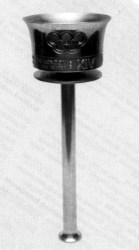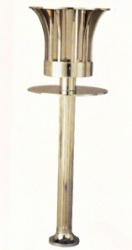Torch and Torch Relay
| Torch Relay 1948
In September, 1946, the Organising Committee decided that the lighting of the Sacred Fire should be carried out by a Torch kindled in the traditional manner at Olympia, in Greece, and carried by relays of runners across Europe to London. It was soon discovered that to repeat the arrangements of 1936 would be so costly as to be quite out of the question. It was therefore necessary so to organise the relay that while capturing the imagination of the public and the spirit of the Olympic torch, the cost would not be prohibitive. For the XI Olympiad, the torch holder was made of stainless steel and the burner element was a magnesium candle. As this had a burning time often minutes at maximum, to ensure ample time at each take-over point, the runners covered only about one kilometre each, running for some three to four minutes. A longer burning time was decided on, to enable each runner to cover two miles (three kilometres) on the flat and thus reduce the number of torches. The Fuel Research Station of the Department of Scientific and Industrial Research was asked to design a suitable container and to recommend a fuel. A metal canister, containing a solid fuel which was already in commercial manufacture and reasonably cheap, met requirements. The holder for the fuel container had to be inexpensive and easy to make but, at the same time, it had to be of pleasing appearance and a good example of British craftsmanship. This latter requirement was particularly necessary as the torches would be on view to the people of many countries during the Relay and afterwards would become mementoes for the runners who would carry them from Olympia to Wembley. |
|
|

| Description: | Inscription: "XIV OLYMPIAD 1948, OLYMPIA TO LONDON, WITH THANKS TO THE BEARER". Cut-out rings over London Olympiad legend at top. |
|---|---|
| Material | Aluminum alloy; |
| Fuel: | Magnesium-based fuel; |
| Torch measure: | Lenght: 47 cm Weight: 960 gr |
| Torches total: | 1,688 |
| Design by: | Ralph Lavers |
| Manufacturer: | |
| Date of the torch relay: | 17. July - 29. Juli 1948 |
| Duration: | 12 days |
| Numbers of runners: | 1,416 |
| Distance total: | 3.160 km |
| Name of the last runner: | John Marks |
The Fuel Research Station started their experiments early in 1947 and in May of that year the first running trials were held. As a result of these trials it was decided to use hexamine in tablet form as the fuel, housed in a perforated canister. In order to make luminous the flame from the hexamine, 6% naphthalene was incorporated in the tablets. It had been agreed that the minimum burning time of each torch should be 15 minutes. As this requirement seemed to be the governing factor, the arrangement of air holes in the fuel canister was made so that, even in a strong wind, the fuel would last for that time. To ensure economy of production, the size of tablets had to be similar to those in commercial production, but these were not large enough to ensure the required burning time if all in the fuel pack were lit on ignition. Eight tablets were therefore placed on a central rod, the bottom three being carried in a cup in the holder; as the top tablets burnt away, these were gradually fed up by a spring. To keep the fuel, which readily absorbed moisture, dry under all weather conditions it had to be kept in an airtight pack which would burn completely, leaving no residue to choke the air holes in the canister. A thin nitro-cellulose casing to hold the eight tablets was specially made for the purpose. When the final prototype torch and holder in sheet metal had been made and tested by the Fuel Research Station, Mr. Ralph Lavers, A.R.I.B.A., accepted an invitation to design an aluminium holder without altering the basic principles of the prototype torch and to supervise manufacture so that all torches would reach the agreed standard. The torch, to be carried by the final runner in the Stadium, had a magnesium flame in order that it would be sufficiently bright to be seen across the Stadium, even in the brightest sunlight. To carry the magnesium candle, a stainless steel holder was required. This also was designed by Mr. Lavers and made by E.M.I. Factories, Ltd. The candle, which was designed to burn for ten minutes, was supplied by Wessex Aircraft Engineering Co., Ltd. All the work on the final torch and torch holder was done without charge. |
|
|
| Country | Distance | Stages | Torches | |
|---|---|---|---|---|
| Greece | 750 km | 300 | 324 | |
| H.M.S. Whitesand Bay |
415 km | - | 6 | |
| Italy | 1,072km | 500 | 540 | |
| Switzerland | 261 km | 135 | 144 | |
| France (1) | 521 km | 270 | 300 | |
| Luxembourg | 108 km | 38 | 42 | |
| Belgium | 287 km | 108 | 120 | |
| France (2) | 126 km | - | - | |
| H.M.S. Bicester | 35 km | - | 12 | |
| England (Dover - Wembley) |
255 km | 73 | 80 | |
| England (Wembley - Torquay) |
330 km | 107 | 120 | |
| Total |
3,160 km | 1,531 | 1,688 |
Organisation of Runners-Route of the Relay
The most direct route from Greece to England was to have been used. This meant a sea passage from Greece to Italy, thence through Switzerland and France, and a sea passage to England. However, two additional countries, Luxembourg and Belgium, asked if the Flame could pass through their territory, and this was agreed. The exact route to be followed was fixed with the Olympic Committees of the countries concerned and the final route decided upon was as follows :
Greece.-Owing to the unsettled state
of the country the Flame went direct from Olympia to the coast at Katakolon,
thence by Greek warship to the island of Corfu. Adriatic.-The Admiralty
willingly gave their co-operation in providing warships to make the sea
passages. From Corfu, H.M.S. Whitesand Bay, a frigate of the Mediterranean
Fleet, carried the Flame to Bari in Italy. Though this passage was planned
to take only 22 hours, H.M.S. Whitesand Bay, had to be ready to carry the
Flame for a period of up to 48 hours in case there was a last minute change
of route in Greece. It was therefore decided that she should burn a gas
Flame, and a special burner for this was made by Spencers (London), Ltd.
It was fed with butane gas, the same fuel as was used for the Flame at
Wembley and Torquay. The burner, piping and gas cylinders were sent to
the Mediterranean by the Admiralty, being shipped in H.M.S. Liverpool in
April, 1948, when she also took the torches for Greece. Italy.-Bari,
Foggia, Pescara, Ancona, Rimini, Bologna, Parma, Piacenza, Milan, Domodossola,
the Simplon Pass.
Switzerland.-Brig, Martigny, Montreux,
Lausanne, Geneva, Perly.
France.-St. Julien en Genevois, Belgarde,
Nantua, Lons-le-Saulnier, Poligny, Besancon, Vesoul, Epinal, Nancy, Metz,
Thionville, Evrange.
Luxembourg.-Frisange, Esch, Luxembourg
City, Ettelbruck, Wiltz.
Belgium.-Bras, Bastogne, Marche, Namur,
Brussels, Renaix, Tournai, Hertain.
France.-Lille, Armentieres, St. Omer,
Calais.
English Channel.-H.M.S. Bicester,
a destroyer of the Nore Command, was detailed to carry the Flame from Calais
to Dover.
England.-The route from Dover to Wembley
passed through the following towns :- Dover, Canterbury, Charing, Maidstone,
Westerham, Redhill, Reigate, Dorking, Guildford, Bagshot, Ascot, Windsor,
Slough, and Uxbridge.
A Torch Relay (England) Committee made the detailed arrangements in England. The members were: The runners were chosen from clubs affiliated to the County Amateur Athletic Associations, one runner from each club being the general rule, with preference given to those clubs through whose area the route passed. Stages in England were as near two miles as possible, change-over points being at places where the runners could shelter in case of bad weather. The route from Wembley to Torquay was as follows
:-Uxbridge, Slough, Maidenhead, Reading, Basingstoke, Andover, Salisbury,
Sherborne, Yeovil, Exeter, Newton Abbot. Final Trials and Distribution of Torches When the route and the number of stages in each country had been completed, torches were packed and shipped. The entire work of design, experiment, production and distribution was carried out in Great Britain. Trials were carried out in a gale of wind with heavy rain and also on a day when it was fine with a light breeze. Under the first conditions the trials were satisfactory, the torches burning for the requisite time, and under the second condition the torches burned for over half an hour when carried by a runner. As the last date for shipping the first batch of torches for Greece had by then been reached, no more trials could be carried out and production was completed with the torches as then designed. A late request for a further 12 torches for
Switzerland was met from the spares retained for such purposes and 20 other
torches were used for demonstrations, trials and as spares in England.
The total number manufactured was thus 1,720. (Source document: Official Report 1948, page 209 - 212) |

